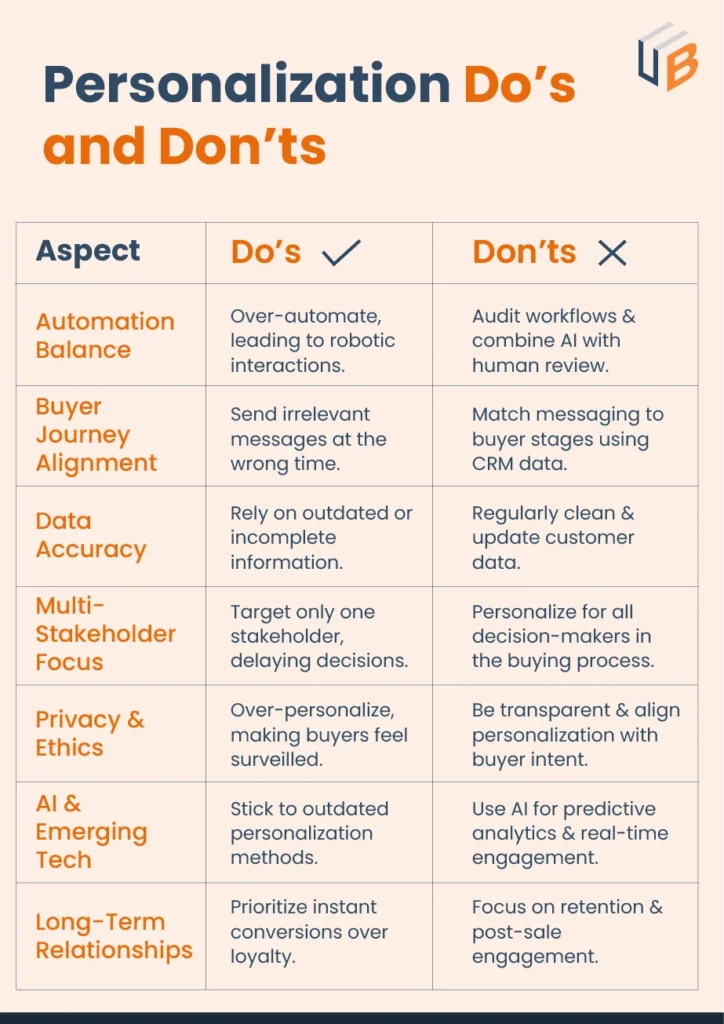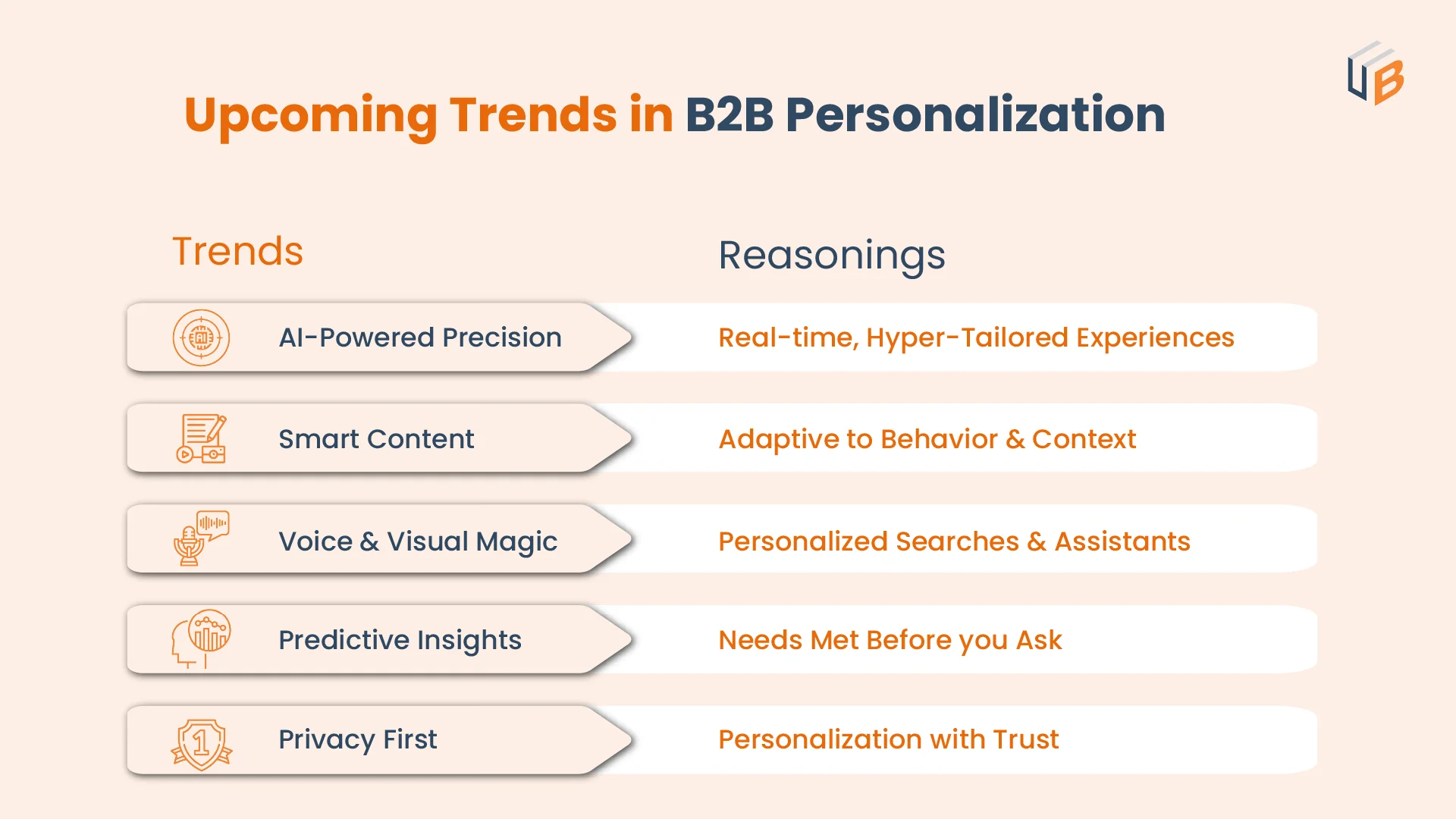
Business success in modern B2B markets depends fundamentally on personalization in B2B marketing, as it represents a critical organizational necessity. Customer expectations now demand that companies demonstrate thorough understanding of individual consumer needs alongside preferences and areas where they need assistance.
Salesforce research highlights that marketing personalization strategies are essential, with 73% of business buyers requiring customized interactions. However, personalization pitfalls can lead to both positive and negative outcomes. A well-executed approach leads to trust formation, and it creates loyal customers.
The execution of personalization through generic messaging or excessive automation produces negative effects that diminish engagement while missing valuable sales prospects.
Marketing managers must optimize automated systems with human touchpoints, maintain data integrity, and align activities with the B2B buyer journey to avoid these B2B marketing mistakes.
Common B2B Personalization Pitfalls and Their Impact
1. Over-Automation
The Mistake: Using automation tools extensively while lacking human supervision leads to generic, irrelevant messages that arrive at wrong times.
The Impact: McKinsey & Company reports that while over 70% of customers expect personalized marketing experiences, 76% feel frustrated when those efforts miss the mark. This reinforces the importance of avoiding over-automation, when personalization feels robotic or irrelevant, it erodes trust and engagement instead of enhancing it.
Example: HSBC utilized automated email campaigns for customer onboarding. However, a failure to segment by account type led to irrelevant offers being sent to premium clients, damaging trust and engagement.
How to Avoid It: Balance automation with human insights. Regularly audit automated workflows and segment your audience with precision, use AI-driven personalization tools like Marketo or HubSpot, and ensure regular human review.
2. Misaligned Messaging
The Mistake: Sending messages that don’t resonate with where the prospect is in their B2B buyer journey.
The Impact: Irrelevant messaging wastes time and resources and risks alienating potential buyers. Forrester research shows that 77% of B2B buyers consider their purchase journey very complex, highlighting the importance of relevance.
Example: Slack targeted enterprise clients with introductory tutorials meant for small teams, leading to confusion and low engagement from decision-makers.
How to Avoid It: Map your messaging to the buyer journey stages—awareness, consideration, and decision. Leverage CRM platforms like HubSpot, Salesforce, or Marketo to track engagement, analyze behavior, and tailor communications accordingly. These tools help ensure prospects receive the right message at the right time, improving relevance and conversion rates.
3. Overlooking Data Accuracy
The Mistake: Personalization programs suffer because marketers continue to use outdated or limited data in their data-driven personalization efforts.
The Impact: Defective data values destroy the effectiveness of performance-based personalization because it leads to situations where customers receive improper greetings or inappropriate recommendations. According to Gartner’s research, marketers will stop trying personalization because of its limitations during 2025.
Example: HubSpot encountered an email failure because automated campaigns used generic placeholders in the greeting rather than actual customer names, triggering strong public criticism.
How to Avoid It: A routine practice of data cleansing and validation must be followed. The customer profile data stays current and precise through the use of tools such as ZoomInfo and Clearbit.
4. Neglecting Multi-Stakeholder Dynamics
The Mistake: Focusing personalization efforts on a single point of contact within a target organization.
The Impact: B2B buying decisions require input from multiple stakeholders, so failing to address all their demands might stop solution adoption. According to Gartner’s survey of 250 B2B customers, nearly 78% described their purchase journey as either extremely complex or nearly impossible to manage.
The complexity of making a purchase decision can be largely attributed to the abundance of high-quality information available to buyers. The typical buying group involves 6 to 10 stakeholders, each of whom have consulted four to five sources of information that they must then deconflict together.
What’s more, 95% of buying groups report having to go back and revisit decisions at least once as new information emerges.
Example: IBM’s account-based marketing strategy once targeted only IT managers, ignoring procurement and financial decision-makers, resulting in slower deal closures.
How to Avoid It: Conduct thorough account-based research to identify all key stakeholders and their priorities. Tailor content to address diverse roles within the buying committee.
5. Over-Personalizing to the Point of Intrusion
The Mistake: Using too much personal or behavioral data in messaging, making prospects feel surveilled.
The Impact: Over-personalization can creep out your audience and damage trust, especially when data usage appears invasive.
“B2B companies sometimes develop highly tailored approaches for their customers, which can lead to inconsistent processes and performance measurement. An example could be customers scheduling maintenance visits personally through their service managers and not submitting a ticket via online solution or sales teams ”overpromising” to customers through very customized approaches, making it more challenging for the delivery organization to meet project budget and timeline, and ultimately customer feeling the promises kept in sales were not delivered.”
— Anna-Maija Tanninen, B2B Customer Experience Advisor | Founder of CX Agency
Example: PwC ran a campaign using highly targeted ads that referenced specific internal searches conducted by potential clients. While the intention was to deliver hyper-relevant content, many recipients were alarmed at how precisely PwC seemed to know what they were searching for, leading to concerns about data privacy.
This approach backfired, eroding trust instead of strengthening engagement. PwC’s study further reinforced this risk, revealing that 71% of customers would stop doing business with companies that mishandle their data or make them feel surveilled.
How to Avoid It: Be transparent about how you collect and use data. Focus on delivering value-driven marketing personalization strategies that aligns with buyer intent without crossing privacy boundaries.
Now, the question arises, Personalization vs. Customization: What’s Best for B2B Buyers?
Personalization and customization both make a big difference in B2B marketing,and they work in different ways. Personalization is like a smart assistant, it predicts what buyers need based on their behavior and offers a solution that feels spot-on. Customization, on the other hand, hands buyers the controls, letting them tweak features or content to fit their exact needs.
So, which one’s better? Honestly, the magic happens when you use both. Personalization keeps things relevant and engaging, while customization gives buyers the freedom to shape their own experience. It’s all about making them feel seen, valued, and in control.
6. Ignoring Emerging Technologies
The Mistake: Failing to integrate generative AI for enhanced personalization in B2B marketing.
The Impact: Sticking to outdated methods can make your personalization efforts less effective and leave you behind competitors such as failing to leverage AI-driven personalization in B2B lead generation can result in missed opportunities, as generic outreach fails to engage today’s data and tech-savvy buyers.Without smart content and predictive insights, conversions drop, and potential leads slip away.
UnboundB2B demonstrates an exemplary B2B lead generation process through its AI-based personalization, intent data analytics and predictive capabilities. Our platform combines modern technology solutions with precise targeting methods to produce sales-ready leads that boost customer engagement and fast-track business deals.
McKinsey reports that businesses using AI-driven personalization achieve up to 40% higher marketing ROI.[McKinsey]
Example: In 2024, S4 Capital experienced an 11% decline in like-for-like revenue, partly because tech clients shifted their spending from traditional marketing to artificial intelligence. This shift highlights the consequences of not aligning with emerging AI trends in marketing strategies.
How to Avoid It: Keep track of generative AI trends as they emerge in B2B marketing. Leverage AI for predictive analytics, dynamic content creation, and real-time engagement.
7. Focusing on Short-Term Gains Over Long-Term Relationships
The Mistake: Personalization strategies that focus exclusively on instant sales conversions neglect the benefits of building enduring customer relationships.
The Impact: The exploitation of prospects drives feelings of undervaluing instead of worth recognition leading to increased customer turnover and damaged brand loyalty. Research conducted by Harvard Business Review proves that when customer retention improves by 5%, businesses experience enhanced profits ranging from 25% to 95% (HBR).
Example: Salesforce previously stressed immediate gains instead of lasting customer success in its early stages before implementing customer success programs to improve client retention rates.
How to Avoid It: Transition from transactional interactions to building customer relationships. Create personalized strategies that build trust through post-purchase follow-ups and individually tailored educational resources that promote long-term customer loyalty.
We’ve done the work for you! Avoid common personalization mistakes with this hand picked list of do’s and don’ts.

Actionable Strategies for Effective Personalization in B2B Marketing
1. Refine Your Data Usage
Invest in Data Management: Implement systems that consolidate and analyze customer data across multi-touchpoints.
Enhance Segmentation: Transform your audience segments into micro-markets so you can create highly relevant content.
2. Align Efforts With Buyer Journeys
Journey Mapping: Use this solution to understand your B2B buyer journey more deeply by combining historical data analysis with customer feedback.
Stage-Specific Content: The content strategy should match different stages using thought leadership materials for awareness while case studies serve decision-making needs.
3. Balance Automation and Human Insights
Personalized Outreach: Sales representatives should combine automated outreach with LinkedIn direct messages and phone calls to deliver personalized interactions.
AI-Driven Personalization: The AI system allows users to run automated conversations through Drift or Conversica platforms, which makes interactions seem authentic and human.
Emerging Trends: Role of Generative AI in Personalization
Generative AI for B2B applications drives a marketing revolution in personalization through these key benefits:.
Dynamic Content Creation: AI-powered tools such as Jasper and ChatGPT enable the production of customized communications like emails and proposals together with advertisements across multiple scales.
Predictive Analytics: You can develop the correct customer offering through predictive analytics, which uses AI to forecast their future actions.
Real-Time Personalization: The Adobe Sensei AI system uses advanced platforms to provide instant contextual recommendation services.

While these advancements offer significant potential, the success of AI-driven personalization depends on its strategic implementation. You should avoid the following:
- Relying on AI without adequate training data.
- Using AI to replace rather than enhance human interaction.
Final Thoughts!
The integration of personalization strategies across multiple platforms must be avoided since inconsistent approaches will break down customer journeys. The mistake of not testing and improving marketing personalization strategies through real-time performance measurements remains an overlooked failure point that generates ineffective marketing campaigns.
Marketers who disregard cultural and regional factors in personalization risk estranging worldwide audiences through messages that seem inappropriate to their customs.
To succeed in the long run, businesses need to use AI-powered personalization wisely, blending automation with a human touch and making sure their efforts match the buyer’s journey. The marketing world is always changing, but companies that focus on smart, data-driven personalization—while avoiding common B2B personalization challenges—will build trust, keep customers engaged, and drive steady growth.
FAQ
1. What is B2B personalization?
B2B personalization is the practice of tailoring marketing, sales, and customer experiences based on a prospect’s needs, behavior, and preferences. It goes beyond just using a name, it’s about delivering the right message, at the right time, through the right channel.2. Why is personalization crucial in B2B marketing?
In B2B marketing, decision-making is complex, and buyers expect relevant, value-driven interactions. Personalization builds trust, improves engagement, and shortens sales cycles by making every touchpoint feel more meaningful and targeted.3. How often should businesses update their personalization strategies?
Personalization strategies should be reviewed and refined continuously, but at a minimum, businesses should update them quarterly. Markets evolve, customer behaviors shift, and AI-driven insights improve, so staying agile ensures your approach remains relevant and effective.
Our blog
Latest blog posts
Tool and strategies modern teams need to help their companies grow.

The 95/5 rule in B2B marketing shows that while only 5% of buyers are ready to purcha...

Running a business comes with its own set of challenges, especially when it comes to ...

AI is surely a futuristic concept but it evolves today, particularly in sales and mar...






